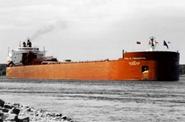Steel Products Prices North America

Status of Great Lakes Iron Ore Shipments
Written by John Packard
November 18, 2014
Vessels carrying iron ore, metallurgical coal, aggregate and grain continue to work under the force majeure created when ice conditions at the start of the shipping season ended up costing the shipping companies 40 days of lost transit time. At the beginning of the season ice conditions were beyond the Coast Guard’s ice breaking capabilities. Lake Superior and the upper rivers were limited to one-way, escorted traffic until the early part of May.
![]() Now we are seeing unusually cold temperatures all across the United States and there are signs that portions of Lake Superior are already starting to form ice.
Now we are seeing unusually cold temperatures all across the United States and there are signs that portions of Lake Superior are already starting to form ice.
The shipping season does not end on Lake Superior until the 15th of January when the Soo Locks close or earlier should ice conditions become dangerous for the vessels.
One of the shipping companies on the Great Lakes told SMU, “We are pushing hard in the final weeks of our season and while water temperatures are lower than “average”, they have not impacted our operation yet. We do recognize that with the cold temperatures, we will start seeing ice being made earlier than normal and that will reduce our efficiency in operating. Wind and weather are always a factor at this time of the year and this year is no exception.
“On the positive side, water levels remain above average and our resulting capabilities have exceeded the anticipated performance that was forecast with an unprecedented late start this spring. With regard to raw materials, we are still sufficiently challenged to meet the demands of the market we serve and will undoubtedly be working until the latest date operationally possible.”

John Packard
Read more from John PackardLatest in Steel Products Prices North America

Nucor slows HRC price climb with $5/ton increase
After eight weeks of double-digit price increases on hot-rolled (HR) coil, Nucor slowed the price rise this week with an increase of $5 per short ton.

Domestic CRC prices surge ahead of imports
The price spread between stateside-produced CR and imports reached its widest margin in over a year.

Evraz raises plate prices $160/ton
Evraz North America (NA) has followed Nucor and SSAB with a plate price increase of its own: up $160 per short ton (st). The increase was effective immediately for all new orders of carbon, high-strength low-alloy, and normalized and quenched-and-tempered plate products, as well as for hot-rolled coil, the steelmaker said in a letter to […]

Nucor lifts HR coil to $820/ton
Nucor has increased its consumer spot price (CSP) for hot-rolled (HR) coil for a fourth consecutive week.

Nucor pushes HR spot price to $790/ton
Nucor increased its consumer spot price (CSP) for hot-rolled (HR) coil to $790 per short ton (st) on Monday, Feb. 10 – a $15/st bump vs. last week. The Charlotte, N.C.-based company has raised its weekly CSP by $40/st over the past three weeks after maintaining tags at $750/st since Nov. 12, according to SMU’s […]
